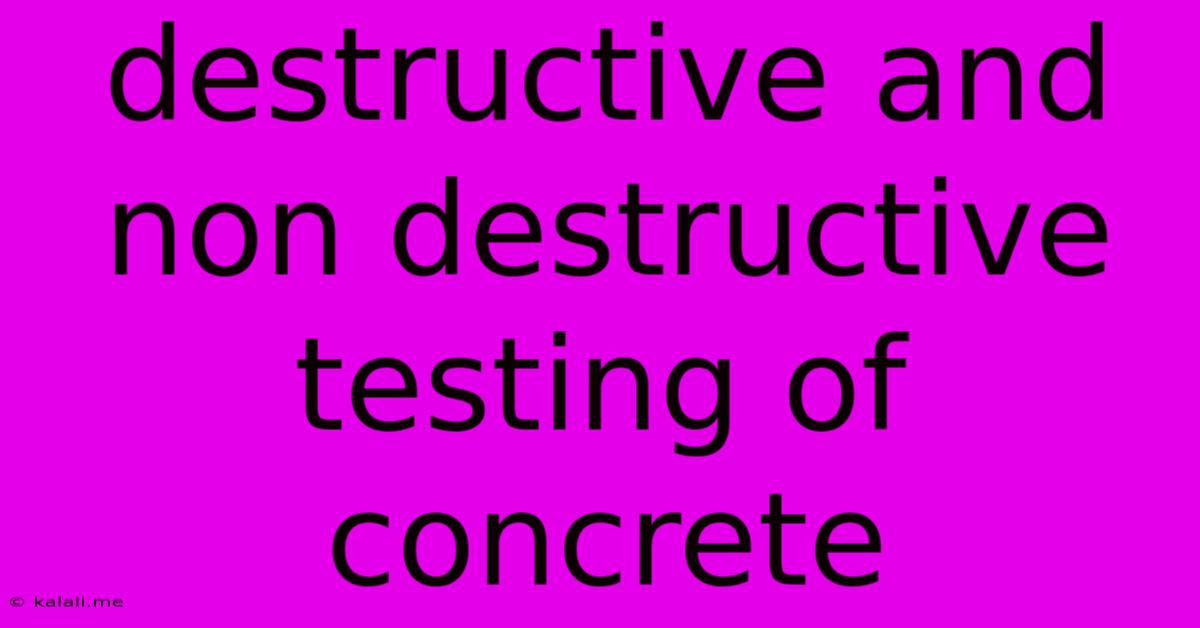Destructive And Non Destructive Testing Of Concrete
Kalali
Jun 16, 2025 · 4 min read

Table of Contents
Destructive and Non-Destructive Testing of Concrete: A Comprehensive Guide
Concrete, a ubiquitous construction material, demands rigorous testing to ensure its quality, durability, and structural integrity. This article delves into the crucial world of concrete testing, exploring both destructive and non-destructive methods, their applications, advantages, and limitations. Understanding these methods is paramount for engineers, contractors, and anyone involved in concrete construction projects. This guide will provide a comprehensive overview, enabling you to choose the most appropriate testing method for your specific needs.
What is Concrete Testing?
Concrete testing is a vital process used to evaluate the properties and performance of concrete. It helps determine whether the concrete meets the required specifications and standards for a given application. This ensures the safety and longevity of structures built using concrete. The tests can be broadly categorized into destructive and non-destructive methods.
Destructive Testing Methods for Concrete
Destructive testing involves damaging or destroying a sample of the concrete to determine its properties. While this method offers precise results, it is often limited to smaller samples and isn't suitable for in-situ testing of large structures. Common destructive tests include:
-
Compressive Strength Test: This is the most common destructive test, measuring the maximum compressive load a concrete cylinder can withstand before failure. It provides crucial information about the concrete's strength and overall quality. This test uses standardized concrete cylinders, typically 6 inches in diameter and 12 inches in height. The results are expressed in psi (pounds per square inch) or MPa (megapascals).
-
Tensile Strength Test: This test measures the concrete's resistance to tensile forces. Methods include splitting tensile strength tests and flexural strength tests. These tests are crucial for evaluating the concrete's ability to withstand cracking and other tensile stresses.
-
Flexural Strength Test: Also known as the modulus of rupture test, this determines the concrete's resistance to bending loads. It involves applying a load to a beam specimen until it fails. This test is particularly useful for evaluating the strength of reinforced concrete elements.
Advantages and Disadvantages of Destructive Testing
Advantages:
- High accuracy and precision: Destructive tests provide precise and reliable data on concrete properties.
- Standardized procedures: Well-established standards ensure consistency and comparability of results.
Disadvantages:
- Destructive nature: Requires the destruction of concrete samples, limiting its use for in-situ testing and potentially causing waste.
- Costly and time-consuming: Sample preparation and testing can be expensive and time-consuming.
- Limited sample size: Results may not be representative of the entire concrete structure.
Non-Destructive Testing (NDT) Methods for Concrete
Non-destructive testing methods evaluate concrete properties without causing damage to the material. These methods are ideal for in-situ testing of existing structures and large concrete elements. Some common NDT methods include:
-
Rebound Hammer Test: This simple and portable test uses a rebound hammer to measure the concrete's surface hardness. The rebound value is correlated with the concrete's compressive strength. This test is quick and easy to perform but its accuracy can be affected by surface conditions.
-
Ultrasonic Pulse Velocity Test: This test measures the speed of sound waves traveling through the concrete. The velocity is related to the concrete's density, elastic modulus, and homogeneity. It helps detect internal flaws such as voids and cracks.
-
Cover Meter Test: This test measures the depth of concrete cover over reinforcing steel bars. This information is crucial for determining corrosion risks and ensuring adequate protection of the reinforcement.
-
Ground Penetrating Radar (GPR): GPR uses electromagnetic waves to image the subsurface structure of concrete, detecting internal voids, cracks, and other anomalies. This is a powerful tool for assessing large concrete structures.
Advantages and Disadvantages of Non-Destructive Testing
Advantages:
- Non-destructive: Allows for in-situ testing without damaging the concrete structure.
- Cost-effective: Generally less expensive and time-consuming than destructive testing.
- Suitable for large structures: Can be used to assess the condition of entire structures.
Disadvantages:
- Lower accuracy compared to destructive tests: Results can be less precise than those from destructive tests.
- Operator skill-dependent: The accuracy of some NDT methods depends on the skill and experience of the operator.
- Limited information: May not provide comprehensive information about all concrete properties.
Choosing the Right Testing Method
The choice between destructive and non-destructive testing depends on various factors including the project's requirements, budget constraints, and the need for precise data versus in-situ evaluation. Often, a combination of both methods is used to obtain a complete picture of the concrete's properties and condition. For example, destructive tests can be used on small samples for quality control during construction, while NDT methods can assess the condition of the completed structure. Careful consideration of these factors will ensure that the most appropriate and effective testing methods are employed.
Latest Posts
Latest Posts
-
How To Create Clickable Image In Html
Jun 16, 2025
-
What Are The Factors Of 121
Jun 16, 2025
-
What Is A Theme Of The Passage
Jun 16, 2025
-
A Company That Provides Access To The Internet
Jun 16, 2025
-
Which Word Is Closest In Meaning To The Underlined Word
Jun 16, 2025
Related Post
Thank you for visiting our website which covers about Destructive And Non Destructive Testing Of Concrete . We hope the information provided has been useful to you. Feel free to contact us if you have any questions or need further assistance. See you next time and don't miss to bookmark.